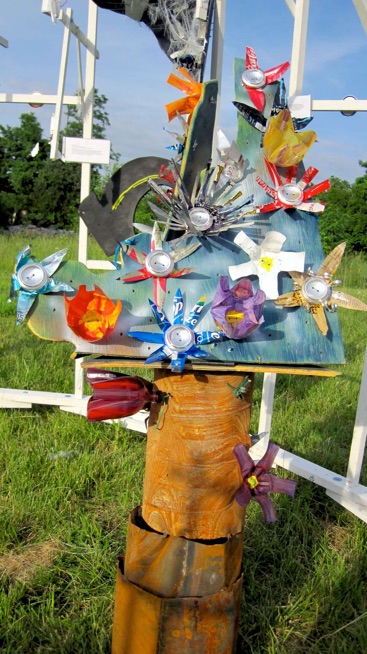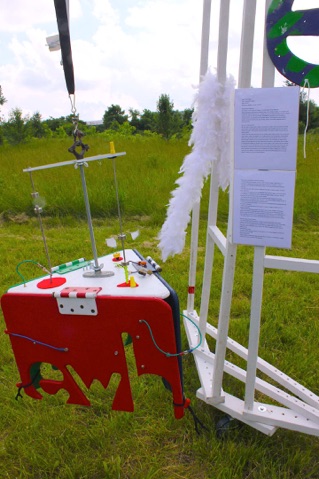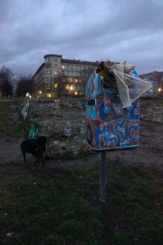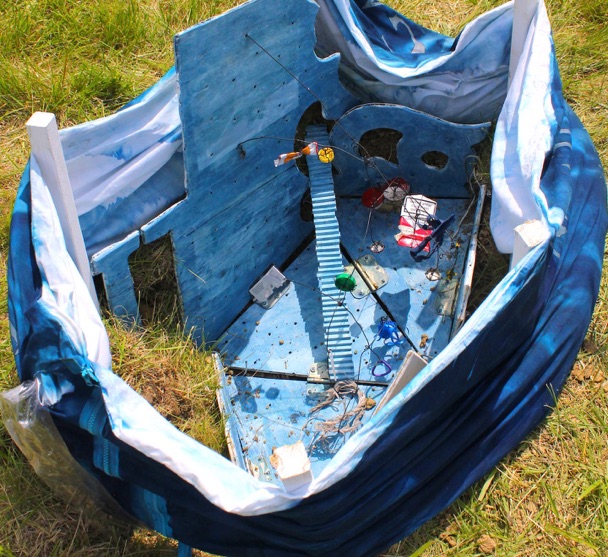Copyright © 2010 - 2017 Marin Abell. info@marinabell.org


















In chase with a museum guard for touching the art. She’s armed with a feather boa-whip custom made by Ted Rogers.















Title: The Collective
Artist: M.J.
Medium: Paper, dryer lint, plastic gems, and fabric.
Statement: I’m drawn to the idea that each of us comes into this earth with a unique gift only he can make - a contribution ostensibly commonplace in a world seemingly mundane; yet in reality, a gift that’s absolutely significant and that’s reflected in the host of small decisions one makes.
The colored paint strips I’ve chosen are meant to evoke vibrant Tibetan prayer flags traditionally hung in the wind to bless the countryside. In this work, each flag is unique: its color represents a single person’s energy; a torn scrap of daily newspaper glued to the flag symbolizes that person’s day-to-day experience; the face or object that was then glued to the newspaper denotes the unique decisions and in turn the impacts the individual makes on the community as he channels his energy through use of free will in his everyday experience. The consequence of small decisions and actions have the potential to amplify throughout the collective, for good or ill, as each individual’s action in turn influences those of his neighbors.
Artist: Daisy Smith
Title: Transformations, Recycle, Reuse, Rebirth
Statement: While I do not confine myself to any particular subject matter or material, I do prefer to capture movement, vitality, and the expressive side of my subject. Subjects for my artwork range from anything I find beautiful or interesting, to an idea or social issue. Regardless of concept or medium, I like to experiment and push boundaries.
I made a flower garden using found objects and recycled materials because rebirth and a healthy planet was the concept I wanted to relay. I painted the wood to mimic a view of Earth from space, suggesting that we can make our planet healthier by finding new uses for recycled products. I used cans and bottles to sculpt flowers, and discarded chicken wire to secure the flowers to the base and the metal I used for a pedestal. The materials themselves relay the ideas of reuse and recycling, while the flowers symbolize the rebirth and renewal our planet would undergo if we executed these practices.
Artist: Ted Rogers
Title: Connection Cabaret
Statement: My intent was to create a play of connections in action, and do so in a way that demonstrates the connection of art and science. Some connections are static, some dynamic, some easily seen, some not so easy, some you may need to ponder, and some, I trust, you will conceive yourself. The medium consists of wood, wire, magnetism, gravitational force and items that bind objects together.
The word “bind” has many synonyms, such as combine, fasten, secure, join, connect, tie, unite, contain, merge, bring together, etc. Usually, we think of the binding item uniting objects together through physical contact, such as wire. There is also binding that does not require direct physical connection, such as magnets and mass, where the binding is caused by magnetic and gravitational force fields. What about other binding, like the binding of inquisitiveness between an observer and a curious object? Or the emotions we feel internally? Or our senses that connect us to others and to the external world? My goal is for the observer to see and feel how this play of simple binding materials represents how everything can be considered to be made of nothing but connections, even the human observer.
This work incorporates binding forces that demonstrate the following:
-
a)The magnets with their magnetic fields indicate attraction as well as repulsion, similar to an outstretched hand capable of giving/taking/pulling/pushing.
-
b)Localized forces; although in close proximity, the attachment can break easily with the slightest movement.
-
c)Shadows connecting the objects to surfaces, merging 3-D objects into 2-D colorless silhouettes.
-
d)Three electrical connections each with a certain human message. One shows a joining of two exposed, unprotected leads. Another is a joining with a female gender lead having to supply the protection. The last represents the desire to be in a joint relationship. All that is necessary is for one or both to relocate one step closer, indicated by the other screw.
-
e)The religion alligator clip is trying to stop the tree of knowledge but cannot overcome the pull.
selected participants’ creations
The piece I created was inspired by two experiences I had prior to the Else-ing Elsewhere exhibition. In December 2013, I was invited to Berlin’s Zentrum fur Kunst und Urbanistics (The Center for Art and Urbanistics), a residency to explore Berlin; the second was a visit to the Modern wing of the National Gallery of Art in Washington D.C. in May 2014.
This kit has images and artifacts collected from Berlin’s Görlitzer Park (a transformed World War II bombed train station) composed onto a re-envisioned National Gallery of Art Modern wing (of Washington D.C.) in which the Modern’s main gallery and iconic Alexander Calder mobile have been implanted into the ground. This proposed basement-level format would free the museum’s street entry level to fill up and spill over with new art, but does so in a way that consciously honors the past by acknowledging the shoulders on which it stands, literally.
For the last 31 years that I have visited the Modern, a suspended Calder mobile has occupied the airspace of its massive yet empty main gallery, and it’s frustrating to think about how many artists will never exhibit there. The irony is that Calder’s work was radical because it was about mobility, but the Modern wing has become static - it hasn’t changed to support emerging and established artists, and the Calder doesn’t even move.

My entire structure, including the shovels and tree-bladder used to represent the installation and nurturing of new art, have been exposed to the cyanotype photo process to subtly present images of Berlin’s Görlitzer Park that I captured in 2013. I visited Berlin to explore how allusive reinventions of the city’s architectural and cultural landscapes might be channeled into my own backyard as currents for discussion and change. In Berlin I learned that virtually the entire city was destroyed, and I was inspired by the conscious effort to leave the scars of its past intact. For example, the Pergamon Museum still stands riddled with pock marks of WWII artillery fire, the Kaiser Wilhelm Church belfry is still battered from past bombing raids, etc. In encountering rumors of Görlitzer Park - a World War II bombed train station turned public park with its crater-like landscape left unfilled - I found a paradox: a destroyed space turned joyful, as evidenced by community orchards, by committees asking the public to take action and transform their space, and by un-removed piles of marble rubble carved into giant talismans by local sculptors. Such reconstructions for new social purposes can be a stimulus for reflection and cultural memory.
This sculpture at Josephine Sculpture Park has become a transportable, mini-Görlitzer Park fabricated of industrial scrapings from areas where I’ve visited (the Calder mobile fabricated specifically out of items I had found in Görlitzer Park), suggesting that authentic transformation involves more than rebuilding on the tabula rasa of a topography; rather, rebuilding requires, and triggers, the conscientious internalization of the many differences in one’s culture only discoverable through enthusiastic dialogue and exploration.
I failed to understand this landscape via handmade camera mounted drone, so I took a closer look and discovered...
Field expedient photo-lab at Josephine Sculpture Park.
1.
3.
2.
A strategy to fuse my teaching with my creative practice was to work on an exhibition with my students. The core of this project was inspired by Elsewhere, a living museum inside a former thrift store in Greensboro, NC where I was invited as a resident in 2013. Elsewhere encourages visitors to handle the collection, and invites artists to re-curate it. ‘Else-ing Elsewhere was conceived as an extension of this concept, however, one that is not rooted to Greensboro, nor to Elsewhere’s collection of objects, but as activities played at home, that are then collectively folded together into a nomadic shape-shifting gallery.
The goal was to empower students with the combined roles of: artist, curator, architect, and gallerist. I provided participants with a plywood kit designed to be transformable. Inspired by Elsewhere’s “no-glue” policy, the kits contained materials that could be used to join objects together into sculptures in a non-invasive way such as with Velcro, rubber bands, tape, paper clips, plastic bags, etc. Participants were encouraged to build a sculpture using any material, and return the kit with their sculpture attached to it, along with a completed questionnaire detailing how they would like their sculpture presented within the gallery. For example, perhaps a sculpture should be installed close to the floor near the entrance, or on the far wall near the ceiling, or as a back lit pedestal piece, etc.
I then affixed their sculpture+kits onto a 2”x4” stud framework (the skeleton of a gallery) that spanned 8’ high and 30’ wide; thus participants were not just creating sculptures, they were also fabricating the gallery itself. The framework stood on large castor wheels.
This project was installed at Josephine Sculpture Park in Frankfort, KY in June 2014.
Marin_Abell_Else_ing_Elsewhere_project_handout.pdf
To view behind the scenes documentation of this project on flickr click here.


Görlitzer Park was an example of honoring the old while welcoming the new.







marin abell